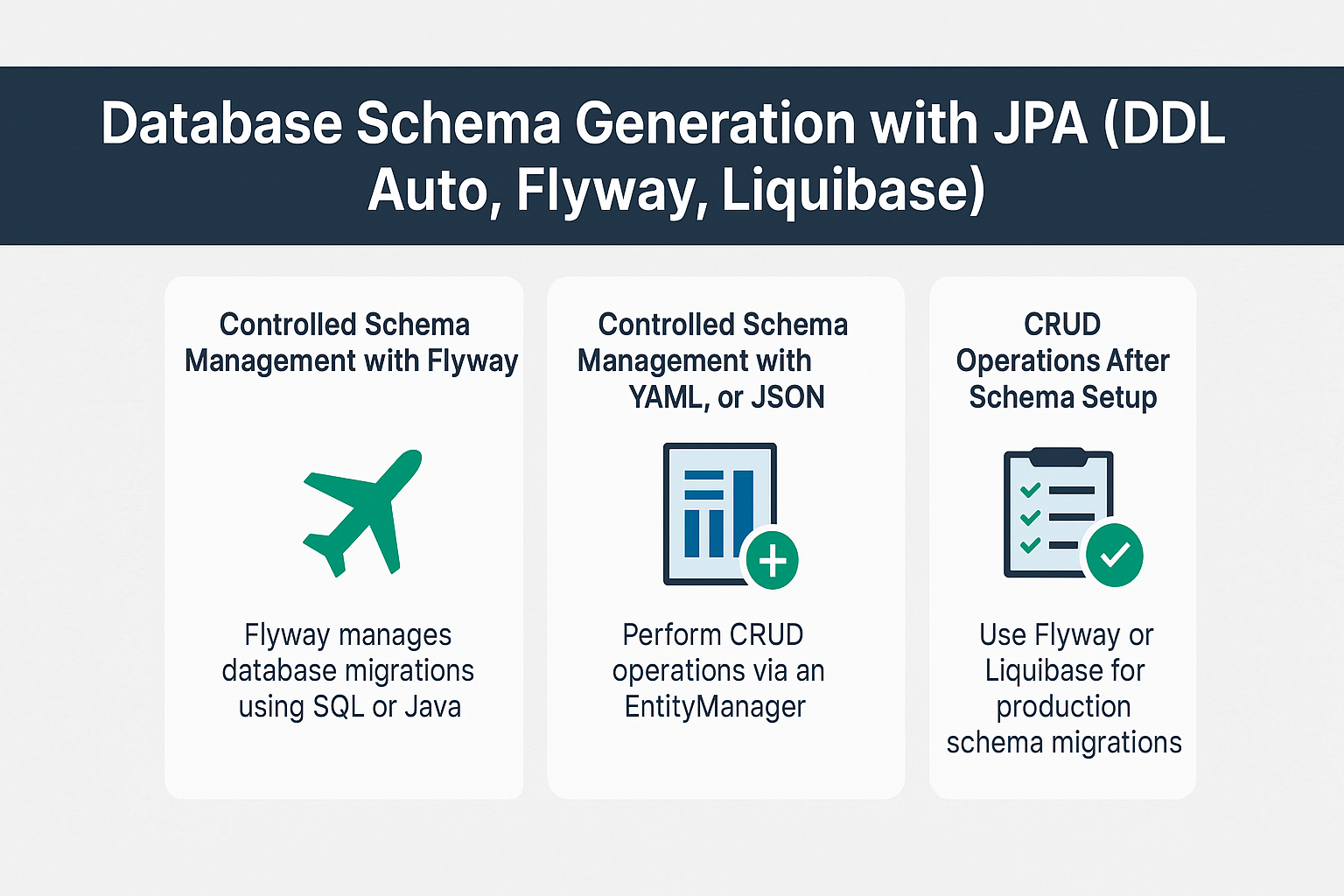When working with relational databases, transactions are the foundation of data integrity. They ensure that a series of operations either complete successfully or leave the database unchanged. In JPA (Java Persistence API), transaction management is critical to handling CRUD operations, persistence context, and database consistency.
Think of a transaction as an ATM withdrawal process: either all steps succeed (PIN verification, balance deduction, cash dispensing), or the system rolls back to the original state if anything fails. Similarly, JPA transactions guarantee atomicity, consistency, isolation, and durability (ACID).
In this tutorial, we will explore JPA transactions with EntityManager, focusing on begin, commit, and rollback, with code examples, best practices, and pitfalls.
Transaction Management in JPA
JPA transactions are controlled through the EntityTransaction API when using RESOURCE_LOCAL transactions, or via JTA (Java Transaction API) in enterprise contexts.
Transaction Lifecycle
- Begin – start a transaction.
- Persist operations – perform CRUD actions within the transaction.
- Commit – save changes permanently.
- Rollback – undo operations if an error occurs.
Setup and Configuration
persistence.xml
<persistence xmlns="https://jakarta.ee/xml/ns/persistence" version="3.0">
<persistence-unit name="my-pu" transaction-type="RESOURCE_LOCAL">
<class>com.example.User</class>
<properties>
<property name="jakarta.persistence.jdbc.driver" value="org.h2.Driver"/>
<property name="jakarta.persistence.jdbc.url" value="jdbc:h2:mem:testdb"/>
<property name="jakarta.persistence.jdbc.user" value="sa"/>
<property name="jakarta.persistence.jdbc.password" value=""/>
<property name="hibernate.hbm2ddl.auto" value="update"/>
<property name="hibernate.show_sql" value="true"/>
</properties>
</persistence-unit>
</persistence>
This configures JPA with RESOURCE_LOCAL transactions.
Entity Example
import jakarta.persistence.*;
@Entity
@Table(name = "users")
public class User {
@Id
@GeneratedValue(strategy = GenerationType.IDENTITY)
private Long id;
private String username;
private String email;
// Getters and Setters
}
Using EntityManager Transactions
Begin and Commit Example
EntityManagerFactory emf = Persistence.createEntityManagerFactory("my-pu");
EntityManager em = emf.createEntityManager();
EntityTransaction tx = em.getTransaction();
try {
tx.begin();
User user = new User();
user.setUsername("ashwani");
user.setEmail("ashwani@example.com");
em.persist(user); // INSERT operation
tx.commit(); // Save changes
} catch (Exception e) {
if (tx.isActive()) {
tx.rollback(); // Undo changes on failure
}
e.printStackTrace();
} finally {
em.close();
emf.close();
}
CRUD with Transactions
Create
tx.begin();
User u = new User();
u.setUsername("kumar");
u.setEmail("kumar@example.com");
em.persist(u);
tx.commit();
Read (no transaction needed for simple find)
User found = em.find(User.class, 1L);
Update
tx.begin();
found.setEmail("updated@example.com");
em.merge(found);
tx.commit();
Delete
tx.begin();
em.remove(found);
tx.commit();
Rollback Example
try {
tx.begin();
User invalidUser = new User();
invalidUser.setUsername(null); // violates NOT NULL
em.persist(invalidUser);
tx.commit();
} catch (Exception e) {
if (tx.isActive()) {
tx.rollback();
System.out.println("Transaction rolled back due to error.");
}
}
Queries with Transactions
JPQL
tx.begin();
List<User> users = em.createQuery("SELECT u FROM User u", User.class).getResultList();
tx.commit();
Criteria API
CriteriaBuilder cb = em.getCriteriaBuilder();
CriteriaQuery<User> cq = cb.createQuery(User.class);
Root<User> root = cq.from(User.class);
cq.select(root).where(cb.equal(root.get("username"), "ashwani"));
List<User> results = em.createQuery(cq).getResultList();
Native SQL
List<User> results = em.createNativeQuery("SELECT * FROM users", User.class).getResultList();
Persistence Context and Transactions
- The Persistence Context tracks managed entities.
- Changes are not flushed until commit.
- Rollback discards unflushed changes.
- Think of it as a classroom attendance register: updated only after the teacher finalizes attendance (commit).
Performance Considerations
- Keep transactions short-lived to avoid database locks.
- Use batch inserts/updates where possible.
- Always handle rollback in error scenarios.
- Avoid long transactions in user-facing apps (causes contention).
Anti-Patterns and Pitfalls
- Forgetting rollback: Leaves transaction open → DB lock.
- Mixing RESOURCE_LOCAL and JTA: Causes conflicts.
- Eager fetching inside transactions: May load unnecessary data.
- Not closing EntityManager: Resource leaks.
Best Practices
- Always wrap transactions in try-catch-finally.
- Use programmatic rollback for error recovery.
- In Spring Boot, prefer
@Transactionalinstead of manual handling. - Monitor SQL logs for transaction boundaries.
📌 JPA Version Notes
- JPA 2.0: Introduced Criteria API, Metamodel.
- JPA 2.1: Added Entity graphs, stored procedures.
- Jakarta Persistence: Package migration (
javax.persistence→jakarta.persistence).
Conclusion and Key Takeaways
- Transactions in JPA ensure data consistency.
- Use
begin(),commit(), androllback()wisely. - Keep transactions short and predictable.
- Integrate with Spring Boot or Jakarta EE for declarative transactions.
By mastering JPA transaction handling, you ensure robust, reliable, and production-ready persistence code.
FAQ
1. What’s the difference between JPA and Hibernate?
JPA is a specification; Hibernate is one implementation.
2. How does JPA handle the persistence context?
It caches entities during a transaction to reduce DB hits.
3. What are the drawbacks of eager fetching in JPA?
Loads unnecessary data, slowing transactions.
4. How can I solve the N+1 select problem with JPA?
Use JOIN FETCH or entity graphs.
5. Can I use JPA without Hibernate?
Yes, with EclipseLink or OpenJPA.
6. What’s the best strategy for inheritance mapping in JPA?JOINED for normalization, SINGLE_TABLE for speed.
7. How does JPA handle composite keys?
With @EmbeddedId or @IdClass.
8. What changes with Jakarta Persistence?
Package renamed from javax.persistence to jakarta.persistence.
9. Is JPA suitable for microservices?
Yes, but prefer DTOs for lightweight communication.
10. When should I avoid using JPA?
In large-scale batch processing or NoSQL-first architectures.
